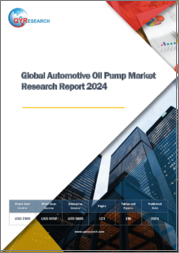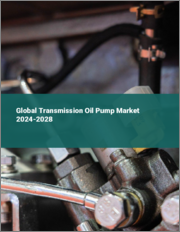
|
시장보고서
상품코드
1381818
세계의 자동차용 오일 펌프 시장 규모 조사 및 예측 : 용도별, 차량 유형별, 지역별 분석(2023-2030년)Global Automotive oil pump Market Size study & Forecast, by Application, by Vehicle Type and Regional Analysis, 2023-2030 |
||||||
최근 자동차 업계에서 엔진 다운사이징이 보편화되는 추세입니다.
이것은 터보차저, 과급기, 직분사 기술과 같은 첨단 기술을 사용하여 달성할 수 있습니다. 자동차 제조업체들은 현재 대형 엔진과 동등하거나 그 이상의 출력을 낼 수 있는 소형 엔진에 집중하고 있습니다. 메르세데스-벤츠와 BMW가 6기통 엔진 대신 4기통 엔진을 탑재하는 것처럼, 이는 차량 무게를 줄이고 연비를 개선하는 데 도움이 됩니다. 이러한 소형화 추세는 정부의 배기가스 규제를 충족시켜야 하는 필요성에 의해서도 촉진되고 있습니다. 향후 몇 년 동안 자동차 연료 분사 펌프 시장은 엔진 소형화에 대한 수요 증가로 인해 새로운 비지니스 기회를 창출할 수 있을 것으로 예상됩니다.
최근 몇 년 동안 세계 자동차 산업은 자동차용 오일 펌프 시장에 큰 영향을 미치는 몇 가지 긍정적인 추세를 보였습니다. 첫째, 2021년 전 세계 소형 상용차(LCV) 생산량은 8%, 승용차 생산량은 2% 증가했습니다. 이러한 자동차 생산량의 전반적인 증가로 인해 오일 펌프를 포함한 자동차 부품 및 부품의 사용량이 증가하고 있습니다. 또한 자동차 산업은 자동차 업그레이드의 필요성에 따라 빠른 속도로 발전과 혁신이 이루어지고 있습니다. 이는 자동차 제조업체와 자동차용 오일 펌프 제조업체에 큰 시장 기회를 창출하고 있습니다. 자동차에 새로운 기술과 기능이 도입됨에 따라 이러한 발전을 지원하는 효율적인 오일 펌프에 대한 수요가 증가할 것으로 예상됩니다.
자동차용 오일 펌프 시장을 이끄는 또 다른 중요한 요인은 선진국과 인구 밀집 지역에서 엄격한 공해 규제를 시행하고 엄격한 배기가스 배출 기준을 설정하고 있다는 점입니다. 이러한 기준은 배출가스를 최소화하기 위해 자동차에 효율적인 오일 순환 시스템을 장착하도록 요구하고 있습니다. 또한, 저렴한 배터리의 가용성과 충전 인프라의 확대는 전기차(하이브리드, 플러그인, 배터리 전기차 포함)의 보급 확대에 기여하고 있습니다. 전기자동차의 수요가 증가함에 따라, 용량 차이는 있지만, 이들 차량에 대한 오일 펌프의 수요도 증가할 것으로 예상됩니다.
자동차용 오일 펌프 세계 시장 조사에서 고려된 주요 지역으로는 아시아태평양, 북미, 유럽, 라틴아메리카, 중동 및 아프리카가 있습니다. 아시아태평양은 2027년까지 자동차용 오일 펌프의 가장 큰 시장으로 부상할 것으로 예상됩니다. 이 지역에는 중국과 인도와 같은 신흥 경제 국가들이 포함되어 있으며, 소비자의 구매력 증가로 인해 자동차 수요가 크게 증가하고 있습니다. 아시아태평양은 이미 최대 자동차 시장이며, 이러한 자동차 수요의 지속은 이 지역의 자동차용 오일 펌프 시장의 성장을 주도하고 있습니다. 최근 아시아태평양에서는 상용차 및 승용차 판매량이 눈에 띄게 증가하고 있습니다. 이러한 자동차 판매 증가는 최적의 성능을 보장하고 배기 가스 규제를 준수하기 위해 효율적인 오일 순환 시스템을 필요로 하기 때문에 자동차용 오일 펌프에 대한 수요를 더욱 촉진하고 있습니다. 자동차 배기가스로 인한 생태계 불균형에 대한 우려는 특히 인도, 중국, 말레이시아, 태국 등의 국가에서 더욱 심화되고 있습니다. 이에 따라 이들 국가의 주요 자동차 제조업체들은 저연비 차량 개발에 주력하고 있으며, 이로 인해 고급 오일 펌프 기술에 대한 수요가 증가하고 있습니다.
이 조사의 목적은 최근 몇 년간 다양한 부문과 국가의 시장 규모를 파악하고 향후 몇 년간 시장 규모를 예측하는 것입니다. 이 보고서는 조사 대상 국가의 산업의 질적, 양적 측면을 모두 포함하도록 설계되었습니다.
또한 시장의 미래 성장을 규정하는 촉진요인과 과제와 같은 중요한 측면에 대한 자세한 정보도 제공합니다. 또한, 주요 기업의 경쟁 상황과 제품 제공에 대한 상세한 분석과 함께 이해관계자들이 투자할 수 있는 미시적 시장에서의 잠재적 기회도 포함합니다.
목차
제1장 주요 요약
제2장 자동차용 오일 펌프 세계 시장 정의와 범위
- 조사 목적
- 시장 정의와 범위
- 산업의 진화
- 조사 범위
- 조사 대상 연도
- 통화 환산율
제3장 자동차용 오일 펌프 세계 시장 역학
- 자동차용 오일 펌프 시장의 영향 분석(2020-2030년)
- 시장 성장 촉진요인
- 저연비차에 대한 수요 상승
- 규제 당국에 의한 엄격한 배기가스 규제 실시
- 시장 과제
- 승용차로의 전동 파워스티어링 탑재 증가
- 시장 기회
- 자동차 산업의 에탄올 연료 사용량 증가
- 시장 성장 촉진요인
제4장 자동차용 오일 펌프 세계 시장 : 산업 분석
- Porter's 5 Force 모델
- 공급 기업의 교섭력
- 구매자의 교섭력
- 신규 참여업체의 위협
- 대체품의 위협
- 경쟁 기업 간의 경쟁 관계
- Porter's 5 Force 영향 분석
- PEST 분석
- 정치
- 경제
- 사회
- 기술
- 환경
- 법률
- 주요 투자 기회
- 주요 성공 전략
- COVID-19 영향 분석
- 파괴적 동향
- 업계 전문가의 관점
- 애널리스트의 결론과 제안
제5장 자동차용 오일 펌프 세계 시장 : 용도별
- 시장 현황
- 자동차용 오일 펌프 세계 시장 : 용도별, 실적 - 잠재성 분석
- 자동차용 오일 펌프 세계 시장 : 용도별 추정·예측 2020-2030년
- 자동차용 오일 펌프 세계 시장 : 하위 부문별 분석
- 전동식
- 기계식
제6장 자동차용 오일 펌프 세계 시장 : 차종별
- 시장 현황
- 자동차용 오일 펌프 세계 시장 : 차종별, 실적 - 잠재성 분석
- 자동차용 오일 펌프 세계 시장 : 차종별 추정·예측 2020-2030년
- 자동차용 오일 펌프 시장, 하위 부문 분석
- 승용차
- 소형 상용차
- 대형 상용차
- 버스·코치
- 오프로드차
제7장 자동차용 오일 펌프 세계 시장 : 지역별 분석
- 주요 국가
- 주요 신흥 국가
- 자동차용 오일 펌프 시장 : 지역별 시장 현황
- 북미
- 미국
- 캐나다
- 유럽의 자동차용 오일 펌프 시장 현황
- 영국
- 독일
- 프랑스
- 스페인
- 이탈리아
- 기타 유럽
- 아시아태평양의 자동차용 오일 펌프 시장 현황
- 중국
- 인도
- 일본
- 호주
- 한국
- 기타 아시아태평양
- 라틴아메리카의 자동차용 오일 펌프 시장 현황
- 브라질
- 멕시코
- 중동 및 아프리카
- 사우디아라비아
- 남아프리카공화국
- 기타 중동 및 아프리카
제8장 경쟁 정보
- 주요 기업 SWOT 분석
- 주요 시장 전략
- 기업 개요
- BorgWarner Inc.
- 주요 정보
- 개요
- 재무(데이터 가용성에 따라 다름)
- 제품 개요
- 최근의 동향
- DENSO CORPORATION
- FTE automotive
- HUSCO Automotive, LLC
- Johnson Electric
- Magna Powertrain, Inc.
- MAHLE Group
- Mikuni American Corporation
- Mitsubishi Electric
- Nidec Corporation
- BorgWarner Inc.
제9장 조사 과정
- 조사 과정
- 데이터 마이닝
- 분석
- 시장 추정
- 검증
- 출판
- 조사 속성
- 조사 가정
As per recent trends in the automotive industry, engine downsizing is becoming a popular practice. This is achieved by using advanced technologies such as turbochargers, superchargers, and direct injection technology. Automakers are now focusing on smaller engines that can deliver power equal to or greater than larger engines. This helps to reduce vehicle weight and improve fuel efficiency, as seen in the case of Mercedes-Benz and BMW cars that are now equipped with 4-cylinder engines instead of 6-cylinder engines. This downsizing trend is also driven by the need to meet government emission regulations. In the coming years, the automotive fuel injection pump market is expected to benefit from the growing demand for downsized engines and present new business opportunities.
In recent years, the global automotive industry has witnessed several positive trends that had a significant impact on the market for automotive oil pumps. Firstly, in 2021, there was a notable increase of 8% in the production volume of light commercial vehicles (LCVs) worldwide, while passenger car production experienced a 2% growth. This overall rise in automobile production has led to an increased usage of automotive parts and components, including oil pumps. Furthermore, the automotive industry has been experiencing a rapid pace of advancements and innovation, accompanied by the need to upgrade vehicles. This has created substantial market opportunities for automakers and manufacturers of automotive oil pumps. As new technologies and features are introduced in vehicles, the demand for efficient oil pumps to support these advancements is expected to grow.
Another important factor driving the market for automotive oil pumps is the enforcement of stringent emission standards in developed and densely populated areas with strict pollution regulations. These standards require vehicles to have efficient oil circulation systems to minimize emissions. Additionally, the availability of cheaper batteries and the expansion of charging infrastructure have contributed to the increased adoption of electric vehicles (including hybrid, plug-in, and battery electric vehicles). As the demand for electric vehicles grows, the need for oil pumps in these vehicles, albeit in a different capacity, is expected to expand as well.
The key regions considered for the Global Automotive oil pump Market study includes Asia Pacific, North America, Europe, Latin America, and Middle East & Africa. The Asia Pacific region is projected to emerge as the largest market for automotive oil pumps by 2027. This region encompasses rapidly developing economies such as China and India, where the growing purchasing power of consumers has significantly increased the demand for automobiles. The Asia Pacific region already holds the title of the largest market for automotive vehicles, and this sustained demand for vehicles is driving the growth of the automotive oil pump market in the region. In recent years, there has been a notable increase in the sales of both commercial vehicles and passenger cars in the Asia Pacific region. This growth in vehicle sales further fuels the demand for automotive oil pumps, as these vehicles require efficient oil circulation systems to ensure optimal performance and comply with emission regulations. The concerns surrounding ecological imbalances caused by vehicle emissions have particularly intensified in countries like India, China, Malaysia, and Thailand. As a result, major vehicle manufacturers in these countries have shifted their focus towards developing low fuel-consuming vehicles, which in turn increases the demand for advanced oil pump technologies.
Major market player included in this report are:
- BorgWarner Inc.
- DENSO CORPORATION
- FTE automotive
- HUSCO Automotive, LLC
- Johnson Electric
- Magna Powertrain, Inc.
- MAHLE Group
- Mikuni American Corporation
- Mitsubishi Electric
- Nidec Corporation
Recent Developments in the Market:
- In February 2022, Moroso Performance Products, a U.S.-based company, introduced a new external, single-stage oil pump with reverse rotation and a fuel pump drive. This innovative pump design is positioned at the front of the car on a mounting bracket that resembles the left side door of a car. It incorporates internal pumps for ease of adjustment and features an exterior pump that operates at a cooler temperature, improving overall efficiency.
- In January 2022, Toyoda Gosei Co., Ltd., a Japanese manufacturer of plastic and rubber automotive components, developed a lightweight oil pump by utilizing plastic materials instead of metal for certain pump parts. Leveraging its precision molding technology, the company successfully created plastic oil pump gears and other modules. This adoption of plastic components helped achieve a weight reduction of approximately 30% in the pump. The lightweight oil pump is expected to be utilized in Toyota Motor's hybrid Noah and Voxy models, showcasing the benefits of reduced weight and improved efficiency.
Global Automotive oil pump Market Report Scope:
- Historical Data - 2020 - 2021
- Base Year for Estimation - 2022
- Forecast period - 2023-2030
- Report Coverage - Revenue forecast, Company Ranking, Competitive Landscape, Growth factors, and Trends
- Segments Covered - Application, Vehicle Type, Region
- Regional Scope - North America; Europe; Asia Pacific; Latin America; Middle East & Africa
- Customization Scope - Free report customization (equivalent up to 8 analyst's working hours) with purchase. Addition or alteration to country, regional & segment scope*
The objective of the study is to define market sizes of different segments & countries in recent years and to forecast the values to the coming years. The report is designed to incorporate both qualitative and quantitative aspects of the industry within countries involved in the study.
The report also caters detailed information about the crucial aspects such as driving factors & challenges which will define the future growth of the market. Additionally, it also incorporates potential opportunities in micro markets for stakeholders to invest along with the detailed analysis of competitive landscape and product offerings of key players. The detailed segments and sub-segment of the market are explained below:
By Application:
- Electric Oil Pump
- Mechanical Oil Pump
By Vehicle Type:
- Passenger Vehicles
- Light Commercial Vehicles
- Heavy Commercial Vehicles
- Buses & Coaches
- Off-road Vehicles
By Region:
- North America
- U.S.
- Canada
- Europe
- UK
- Germany
- France
- Spain
- Italy
- ROE
- Asia Pacific
- China
- India
- Japan
- Australia
- South Korea
- RoAPAC
- Latin America
- Brazil
- Mexico
- Middle East & Africa
- Saudi Arabia
- South Africa
- Rest of Middle East & Africa
Table of Contents
Chapter 1. Executive Summary
- 1.1. Market Snapshot
- 1.2. Global & Segmental Market Estimates & Forecasts, 2020-2030 (USD Billion)
- 1.2.1. Automotive oil pump Market, by Region, 2020-2030 (USD Billion)
- 1.2.2. Automotive oil pump Market, by Application, 2020-2030 (USD Billion)
- 1.2.3. Automotive oil pump Market, by Vehicle Type, 2020-2030 (USD Billion)
- 1.3. Key Trends
- 1.4. Estimation Methodology
- 1.5. Research Assumption
Chapter 2. Global Automotive oil pump Market Definition and Scope
- 2.1. Objective of the Study
- 2.2. Market Definition & Scope
- 2.2.1. Industry Evolution
- 2.2.2. Scope of the Study
- 2.3. Years Considered for the Study
- 2.4. Currency Conversion Rates
Chapter 3. Global Automotive oil pump Market Dynamics
- 3.1. Automotive oil pump Market Impact Analysis (2020-2030)
- 3.1.1. Market Drivers
- 3.1.1.1. Growing demand for fuel-efficient vehicles
- 3.1.1.2. Implementation of stringent emission norms by regulatory authorities
- 3.1.2. Market Challenges
- 3.1.2.1. Increase in installation of electric power steering in passenger cars.
- 3.1.3. Market Opportunities
- 3.1.3.1. Growth in usage of ethanol fuel in automotive industry
- 3.1.1. Market Drivers
Chapter 4. Global Automotive oil pump Market Industry Analysis
- 4.1. Porter's 5 Force Model
- 4.1.1. Bargaining Power of Suppliers
- 4.1.2. Bargaining Power of Buyers
- 4.1.3. Threat of New Entrants
- 4.1.4. Threat of Substitutes
- 4.1.5. Competitive Rivalry
- 4.2. Porter's 5 Force Impact Analysis
- 4.3. PEST Analysis
- 4.3.1. Political
- 4.3.2. Economical
- 4.3.3. Social
- 4.3.4. Technological
- 4.3.5. Environmental
- 4.3.6. Legal
- 4.4. Top investment opportunity
- 4.5. Top winning strategies
- 4.6. COVID-19 Impact Analysis
- 4.7. Disruptive Trends
- 4.8. Industry Expert Perspective
- 4.9. Analyst Recommendation & Conclusion
Chapter 5. Global Automotive oil pump Market, by Application
- 5.1. Market Snapshot
- 5.2. Global Automotive oil pump Market by Application, Performance - Potential Analysis
- 5.3. Global Automotive oil pump Market Estimates & Forecasts by Application 2020-2030 (USD Billion)
- 5.4. Automotive oil pump Market, Sub Segment Analysis
- 5.4.1. Electric Oil Pump
- 5.4.2. Mechanical Oil Pump
Chapter 6. Global Automotive oil pump Market, by Vehicle Type
- 6.1. Market Snapshot
- 6.2. Global Automotive oil pump Market by Vehicle Type, Performance - Potential Analysis
- 6.3. Global Automotive oil pump Market Estimates & Forecasts by Vehicle Type 2020-2030 (USD Billion)
- 6.4. Automotive oil pump Market, Sub Segment Analysis
- 6.4.1. Passenger Vehicles
- 6.4.2. Light Commercial Vehicles
- 6.4.3. Heavy Commercial Vehicles
- 6.4.4. Buses & Coaches
- 6.4.5. Off-road Vehicles
Chapter 7. Global Automotive oil pump Market, Regional Analysis
- 7.1. Top Leading Countries
- 7.2. Top Emerging Countries
- 7.3. Automotive oil pump Market, Regional Market Snapshot
- 7.4. North America Automotive oil pump Market
- 7.4.1. U.S. Automotive oil pump Market
- 7.4.1.1. Application breakdown estimates & forecasts, 2020-2030
- 7.4.1.2. Vehicle Type breakdown estimates & forecasts, 2020-2030
- 7.4.2. Canada Automotive oil pump Market
- 7.4.1. U.S. Automotive oil pump Market
- 7.5. Europe Automotive oil pump Market Snapshot
- 7.5.1. U.K. Automotive oil pump Market
- 7.5.2. Germany Automotive oil pump Market
- 7.5.3. France Automotive oil pump Market
- 7.5.4. Spain Automotive oil pump Market
- 7.5.5. Italy Automotive oil pump Market
- 7.5.6. Rest of Europe Automotive oil pump Market
- 7.6. Asia-Pacific Automotive oil pump Market Snapshot
- 7.6.1. China Automotive oil pump Market
- 7.6.2. India Automotive oil pump Market
- 7.6.3. Japan Automotive oil pump Market
- 7.6.4. Australia Automotive oil pump Market
- 7.6.5. South Korea Automotive oil pump Market
- 7.6.6. Rest of Asia Pacific Automotive oil pump Market
- 7.7. Latin America Automotive oil pump Market Snapshot
- 7.7.1. Brazil Automotive oil pump Market
- 7.7.2. Mexico Automotive oil pump Market
- 7.8. Middle East & Africa Automotive oil pump Market
- 7.8.1. Saudi Arabia Automotive oil pump Market
- 7.8.2. South Africa Automotive oil pump Market
- 7.8.3. Rest of Middle East & Africa Automotive oil pump Market
Chapter 8. Competitive Intelligence
- 8.1. Key Company SWOT Analysis
- 8.1.1. Company 1
- 8.1.2. Company 2
- 8.1.3. Company 3
- 8.2. Top Market Strategies
- 8.3. Company Profiles
- 8.3.1. BorgWarner Inc.
- 8.3.1.1. Key Information
- 8.3.1.2. Overview
- 8.3.1.3. Financial (Subject to Data Availability)
- 8.3.1.4. Product Summary
- 8.3.1.5. Recent Developments
- 8.3.2. DENSO CORPORATION
- 8.3.3. FTE automotive
- 8.3.4. HUSCO Automotive, LLC
- 8.3.5. Johnson Electric
- 8.3.6. Magna Powertrain, Inc.
- 8.3.7. MAHLE Group
- 8.3.8. Mikuni American Corporation
- 8.3.9. Mitsubishi Electric
- 8.3.10. Nidec Corporation
- 8.3.1. BorgWarner Inc.
Chapter 9. Research Process
- 9.1. Research Process
- 9.1.1. Data Mining
- 9.1.2. Analysis
- 9.1.3. Market Estimation
- 9.1.4. Validation
- 9.1.5. Publishing
- 9.2. Research Attributes
- 9.3. Research Assumption



















